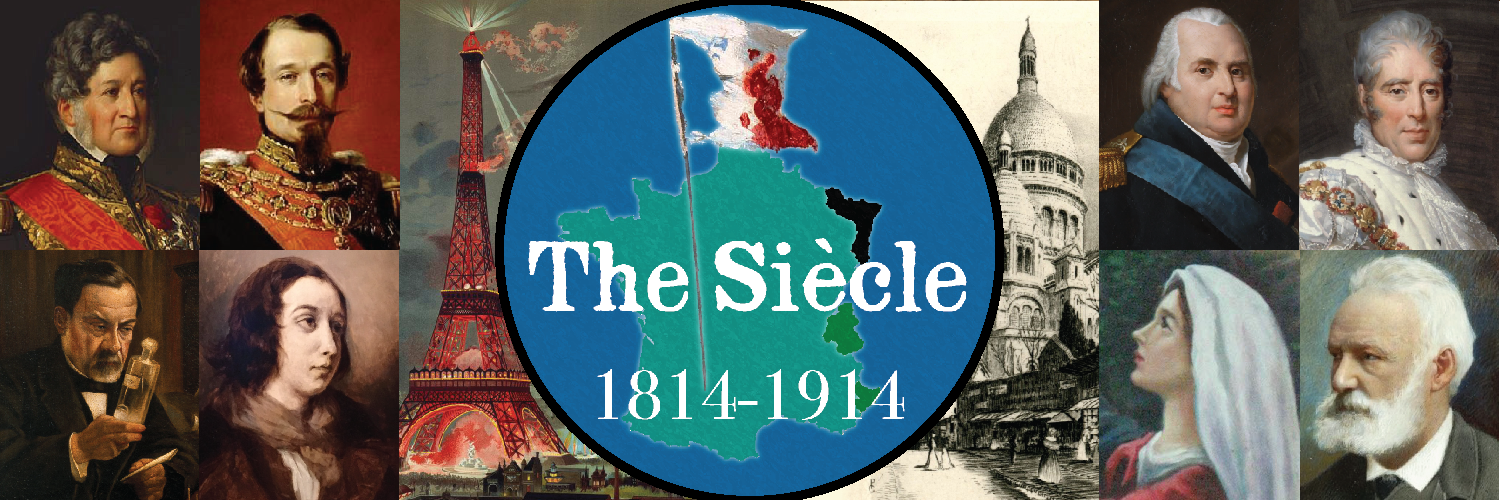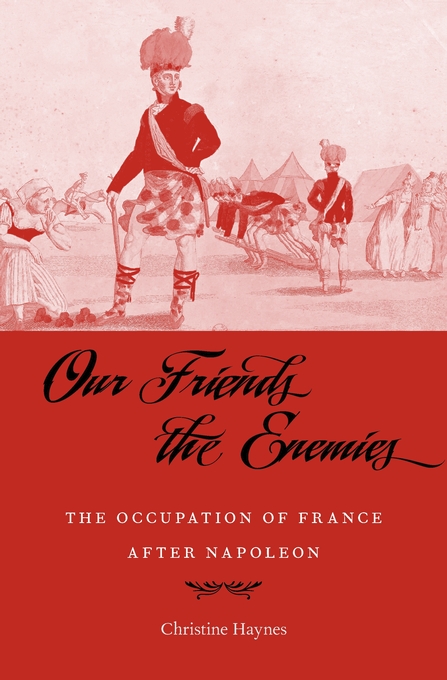Episode 6: Our Friends the Enemies
In Episode 5, we talked about the chaotic aftermath of the Battle of Waterloo, in which France was beset by mob violence, sweeping purges, and foreign invasion. Today, we’re going to delve a little bit deeper into that foreign invasion in a conversation with one of my principal sources: Prof. Christine Haynes.
In our conversation, Haynes talks about her recent book on this occupation, which chronicles both the brutal invasion of summer 1815, as well as the fascinating and more structured occupation to which parts of France were subjected to for years after Waterloo. It turns out that this occupation had fascinating, long-term impacts on both European politics and European culture.
If you visit thesiecle.com/episode6 — that’s t-h-e-s-i-e-c-l-e dot com, slash episode6, with six as a numeral, you can find a transcript of this interview. You can also find a link to buy Prof. Haynes’ fascinating book, which is also a way to support the podcast, because if you buy from the link on the website, Amazon will give me a small cut of the sale price. You can find other ways to support the podcast at thesiecle.com/support, where you can contribute as little as a dollar a month to the show’s Patreon, like recent backer Jacob Hufstader, or purchase me books for the show from an Amazon wishlist, like listener Dave Kamper.
Without further ado, here’s my discussion with Prof. Christine Haynes. This is The Siècle, Episode 6: Our Friends the Enemies.
THE SIÈCLE: My guest today is Christine Haynes, associate professor at the University of North Carolina at Charlotte, and the author of Our Friends the Enemies: The Occupation of France After Napoleon. I brought Professor Haynes on to talk a little bit about her book, and about this chaotic period after Waterloo, after the end of the Napoleonic Wars, and is really going to shape a lot of the French history that’s going to happen in the years and decades to come.
CHRISTINE HAYNES: Thank you so much for taking the time to talk to me. I’m really excited for the opportunity.

Prof. Christine Haynes, associate professor at the University of North Carolina at Charlotte.
SIÈCLE: Let’s start out by talking about your book. How did you come to get interested in this topic of the occupation of France after the Napoleonic Wars?
HAYNES: Well, I’m really glad that you are doing this podcast on the 19th Century, which I think is really the most interesting and pivotal period of French history.
I came to this topic through a very circuitous, unusual way. I started off as a student of French literature as well as French history in college, did a junior year abroad in France, and then when I was considering graduate school really wanted to do a project at the intersection of those two fields. I ultimately ended up in a history department for a PhD, working in the field called “book history” — basically the history of printing and publishing — and I wrote a dissertation, which became my first book, on the history of publishing in France during the 19th Century. I was interested in the people who produced the works of people like Balzac, Hugo, Flaubert, Zola, etc. I wrote about the debates that publishers were involved with about things like literary property and licensing for printers.
So I started off in this cross between literary and cultural history, but while I was doing the research for that book, I noticed there were a number of foreign printers and booksellers who were setting up shop in Paris in the eighteen-teens. I started to wonder about why so many foreigners were coming — both in the business and then outside the business — were coming to Paris during that period.
The more I looked into it, the more I realized that it was the context of the aftermath of the Napoleonic Wars, and particularly the occupation of France by the other powers of Europe that was the context for this infusion of outsiders into the publishing business in France.
I started looking into the occupation, trying to find some histories of it, and realized that not much had really been written about it. There had been a few local studies, including by a German historian. One study of the British Army during the occupation. But no one had really written a comprehensive book about about what the experience of occupation was like for the occupied as well as the occupiers during what ended up being a three-year occupation of the country by these Allied powers.
And so, realizing that this was open territory, I decided that that would be my next book project. This required considerable retooling from the field of cultural history to military and diplomatic history, so I had to learn a whole new body of secondary literature and delve into some new kinds of archives than I had used before — including local archives. I had mostly done most of my dissertation research in Paris, in French national archives and libraries. Ultimately, it was a really fun challenge that I couldn’t pass up, and this book is the result of about eight years of work following that first book project.
SIÈCLE: Well, it’s an excellent book. I encourage everyone who’s listening this who finds this topic interesting to pick it up.
For those who aren’t as familiar with the topic as you are, which I assume is everyone, just give a quick grounding in what the context is for this occupation of France. People are familiar with the Revolution and then Napoleon and then his downfall, so talk about a quick bird’s-eye-view overview of this period.
HAYNES: You know, when we think about the Napoleonic Wars, they are usually thought to have ended, first in 1814 and then again when Napoleon comes back for 100 days in power again in 1815. They’re thought to have really definitively ended on the battlefield at Waterloo on June 18, 1815. But in fact, that battle was followed by a massive invasion of France by 1.2 million soldiers from all across Europe. Initially — and I can talk about this in a little more detail in a minute — but initially, there was a military occupation of the country, some two-thirds of the territory, by these soldiers. That goes on through the summer, during extensive, very divisive negotiations between the various Allied powers and the French government about how to resettle France and Europe after this, after Napoleon has come back to power and had to be defeated again.
There had been a peace settlement after his first defeat in 1814, but now that had to be re-negotiated. A lot of the Allies wanted a more punitive settlement, to prevent another resurgence of Napoleon himself or Bonapartism in general.
After months of negotiation between July and November of 1815, they ultimately settle on what was called the Second Treaty of Paris. One of the main terms of that treaty was that this time around, the Allies would not immediately leave, but they would leave an army of occupation, what they called an Occupation of Guarantee against revolution, in France, for up to five years, until France had indemnified the Allies for the cost of re-mobilizing against Napoleon, and until the French had also rebuilt the government and the military in a way that the Allies deemed stable.
So that was the context for this occupation. Ultimately because the French are able to pay off their reparations a little bit early, the occupation ends up lasting three years instead of five. But throughout that period, an occupying army of 150,000 soldiers from most of the powers of Europe is stationed in around 18 garrison communities around the northeastern frontier of France.
SIÈCLE: Let’s focus in on that earlier period, the initial occupation when 1.2 million soldiers from all over Europe were swarming over most of France. What was that like? France had about 30 million people at that time, so an extra 1.2 million is a lot of people. What was the experience of that occupation like?
HAYNES: Even more than the very brief occupation that had happened after Napoleon’s defeat in 1814, this military occupation in the summer and fall of 1815 is chaotic, extensive — like I said, it covered two-thirds of the territory of France — and often quite brutal. Within two weeks of Waterloo the British and Prussian armies arrive in Paris, and by mid-July there’s some 200,000 soldiers stationed, encamped in barracks, sometimes in tents, on the Champs-Élysée and the Bois du Boulogne, in and around Paris, chopping down trees for firewood, requisitioning supplies from the Parisians.
This was a very traumatic and humiliating event for people in the capital. In the book I quote an English observer of this occupation of Paris, Helen Maria Williams. She described the city in 1815 as follows:
Paris itself, though spared the worst evils of war, wears still the aspect of a conquered city. Guarded by foreign troops at all its gates, foreign troops posted at every bridge, and cannon which seemed as it were pointed at the Palace of the Tuileries. The Bois du Boulogne, the high park of Paris, may not be termed a desert rather than a royal domain.
She actually compares it to the wilds of America, “amidst huts framed with logs and branches,” etc., etc.
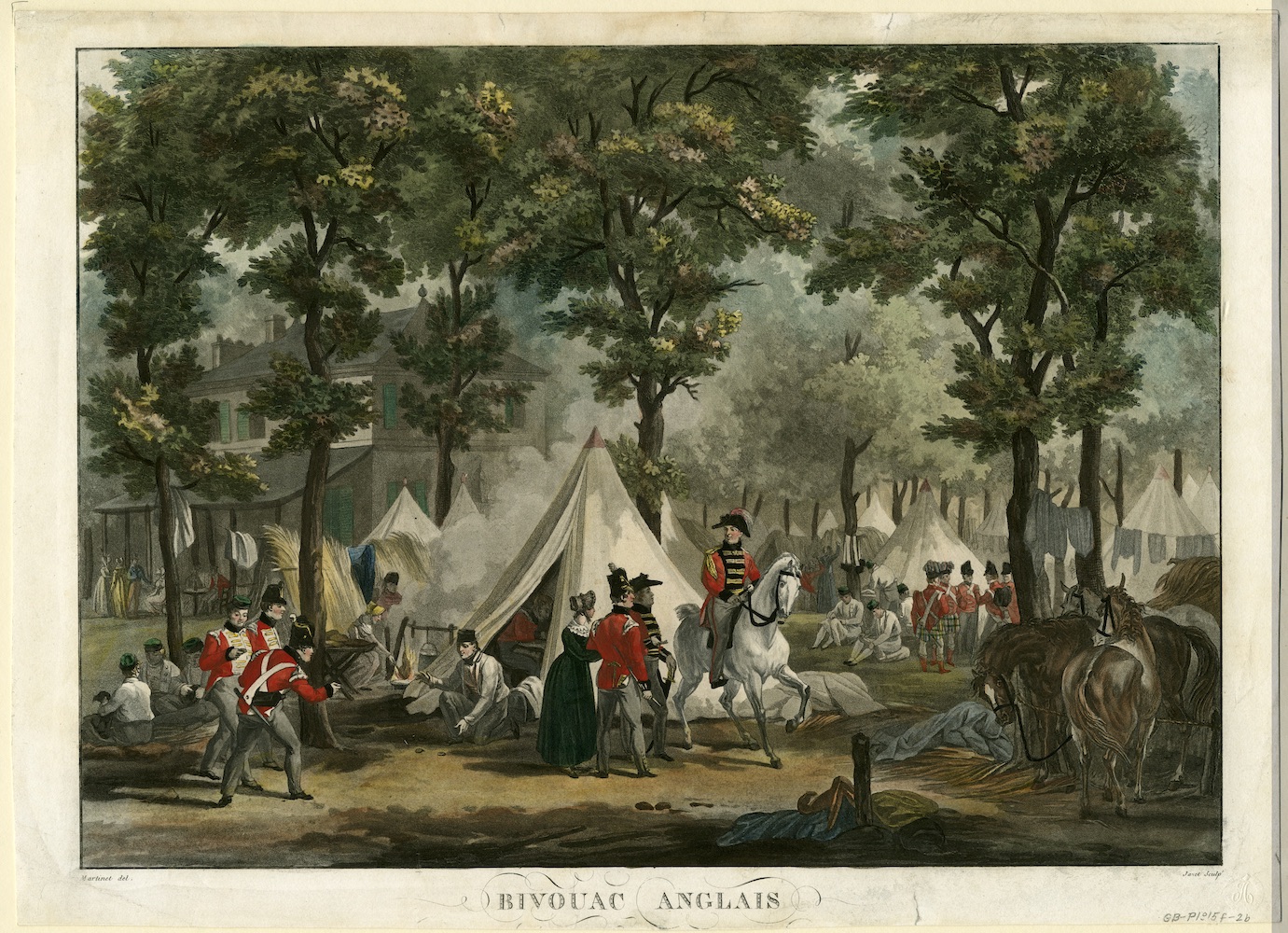
British soldiers encamped in the Bois du Boulogne outside Paris during the post-Waterloo occupation of France. Jean-Pierre-Marie Jazet after Pierre Martinet, “Bivouac Anglais” (1815), Anne S.K. Brown Military Collection, Brown University Library.
This was obviously a shock and, like I said, a humiliation for Parisians. Meanwhile, two-thirds of the west of the country, all the way to the west up to about the borders of Brittany, down to the Loire — the French troops were supposed to evacuate beyond the Loire — all the way down to the Loire, and then all through the eastern half of France, there were troops from most of the other powers of Europe. The rest of those 1.2 million troops were throughout most of the rest of the country.
As they entered, in the weeks after Waterloo, many of them sort of motivated by revenge for what they had experienced at the hands of the French — especially the Prussians, who had themselves suffered occupation by the French after 1806-1807, did not hesitate to engage in violence against the local French and the communities where they were stationed, or where they marched through.
They would move through communities seizing weapons, disarming the local population, plundering supplies, destroying fields, levying contributions, including stores of tobacco, salt — items that were state monopolies — burning villages, raping women, intimidating local authorities. So this was a very brutal invasion and occupation.
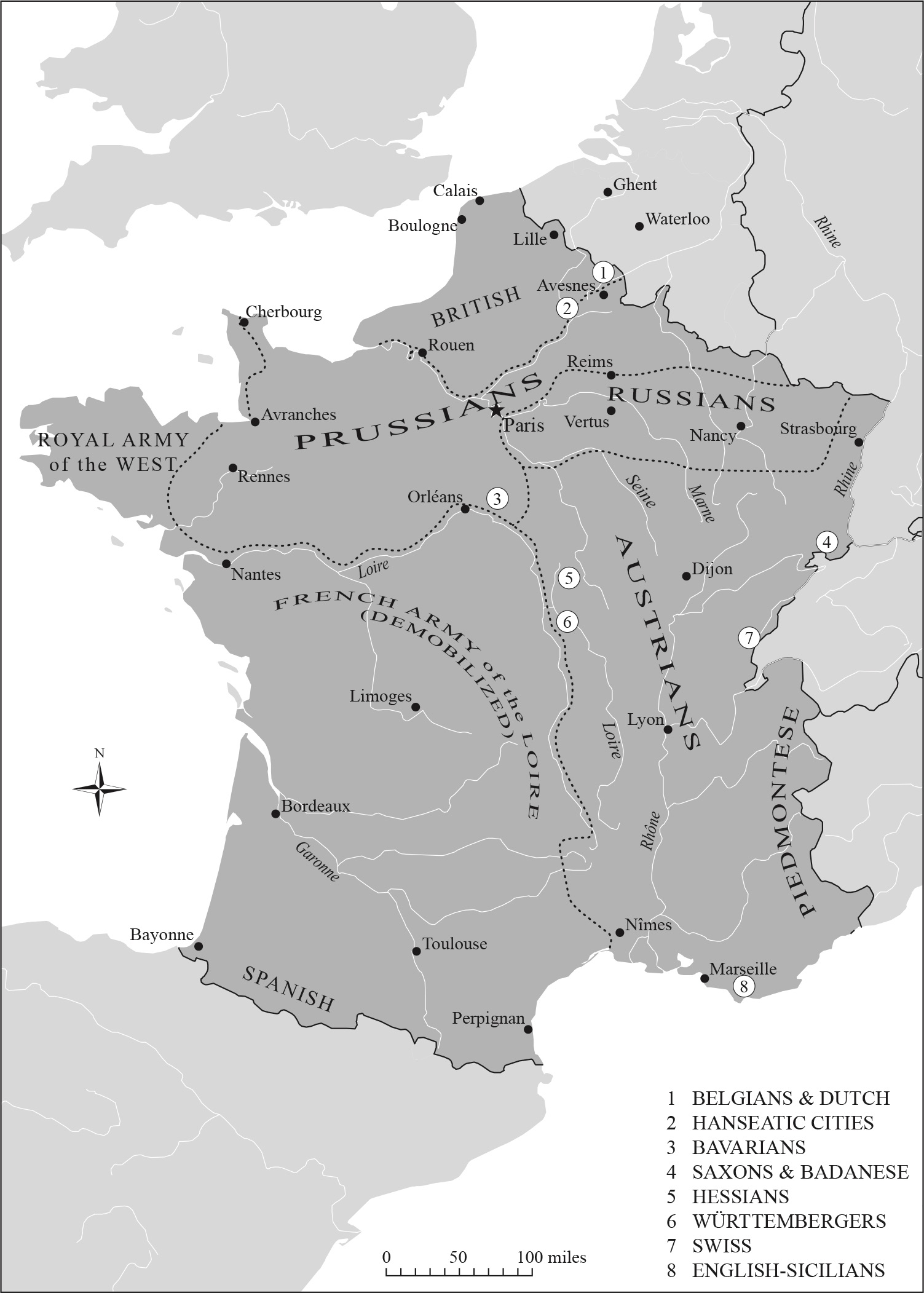
Christine Haynes, “Military occupation, July-November 1815,” adapted from Roger André, L’occupation de la France par les Alliés en 1815: juillet-novembre (Paris: Boccard, 1924), 56-57. Map © Christine Haynes, used with permission.
And meanwhile, I think you’ve already talked about this with your listeners in some previous episodes, this is at exactly the same moment that the White Terror is raging and vengeance is being taken against people who had supported Napoleon during his return to power, during the Hundred Days, so it was really a quite chaotic situation throughout most of the country in the summer of 1815.
SIÈCLE: Do you have any data on the scope of the devastation that was happening here? How many people died during this occupation, or how much money was seized, or anything like that?
HAYNES: It’s very difficult to get numbers on people killed. I would say there were killed on both sides — there are some instances, but very scattered and anecdotal, of vengeance being taken by the local French against some of these occupying troops. So I don’t think we have exact numbers of deaths beyond the White Terror itself, and even those statistics are a bit uncertain. But in terms of expenses, there’s a big difference between trying to calculate what was actually taken out of hand versus what was actually requisitioned with receipts, the amounts of which could be calculated afterwards. But the main French historian of this military occupation during the summer and fall of 1815 has estimated the total costs of the post-Waterloo invasion and occupation at 500 million francs, which was a significant sum during this period.
SIÈCLE: Alright. As you mentioned, while this was all going on, there was treaty negotiations going on, which eventually set up the second occupation, the Occupation of Guarantee, the legally defined occupation, which spared most of the country the direct impacts. Talk about what that second occupation was like, up in the northern part of France.
HAYNES: First I’ll just say that the negotiations over this second settlement, which ultimately became the Second Treaty of Paris in November 1815, were quite contentious. The Prussians and Austrians and some other German contingents on one hand, and some members of the British government, wanted a very punitive settlement against the French, to really punish them for supporting Napoleon and his return to power. Others, particularly Lord Castlereagh, the British foreign minister, and also the Duke of Wellington, who was the victor over Napoleon at Waterloo, took a more moderate approach. And they were supported in this by the Russians.
Wellington in particular really insisted that a punitive settlement was just going to exacerbate political tensions within France, and that the goal of the Allies should be restoring order, restoring security, and that to do that, they needed to be a little bit more liberal in their approach to the French.
What [Wellington] proposed in his effort to make the settlement more moderate was this idea of the Occupation of Guarantee. In this letter to Castlereagh, he really outlined the goals of this temporary occupation. He said that it was:
first to give security to the government of the king, and to afford him time to form a force of his own to carry on his government. Second to give the Allies some security against a second revolutionary convulsion and reaction, and third to enable the Allies to enforce payment of those contributions which they deem it just towards their own subjects to lay on France in payment of the expenses of war.
Those were what he saw as the goals of what he was calling Occupation of Guarantee. He was really trying to prevent further unrest in France and contribute to the reconstruction of France and the rest of Europe. So it’s important to note that there were some differences of opinion between the Allies about how to handle this situation, but ultimately this more moderate approach of Wellington, and in particular the Occupation of Guarantee, became central to the treaty in November of 1815.
Under the terms of this treaty, the Occupation of Guarantee involved 150,000 troops, plus 50,000 horses. It’s important not to forget the horses that came with the troops, because they constituted considerable burden in terms of requisitions and just their physical presence in communities could be burdensome. So, 150,000 troops plus 50,000 horses stationed around 18 garrison towns along the northeastern frontier. This army would be under the integrated command of the Duke of Wellington.
The army was divided into national zones, so there were 30,000 British troops under Wellington in and around the town of Cambrai; 30,000 Russians under Count Mikhail Semyonovich Vorontsov in Maubeuge; 30,000 Prussians under Count von Zieten in Sedan; 30,000 Austrians under Baron Johann Maria Philipp von Frimont in Colmar; and then in addition to that, the Allied powers were very concerned to involve the minor powers of Europe in this as well as the major ones. And so there were also 10,000 Bavarian troops, 5,000 Saxons, 5,000 Hanoverians, 5,000 Danes, and 5,000 troops from Württemberg across the border in the new German Confederation. These were sort of scattered in between — they had their own little zones and headquarters in between the zones of the major powers.
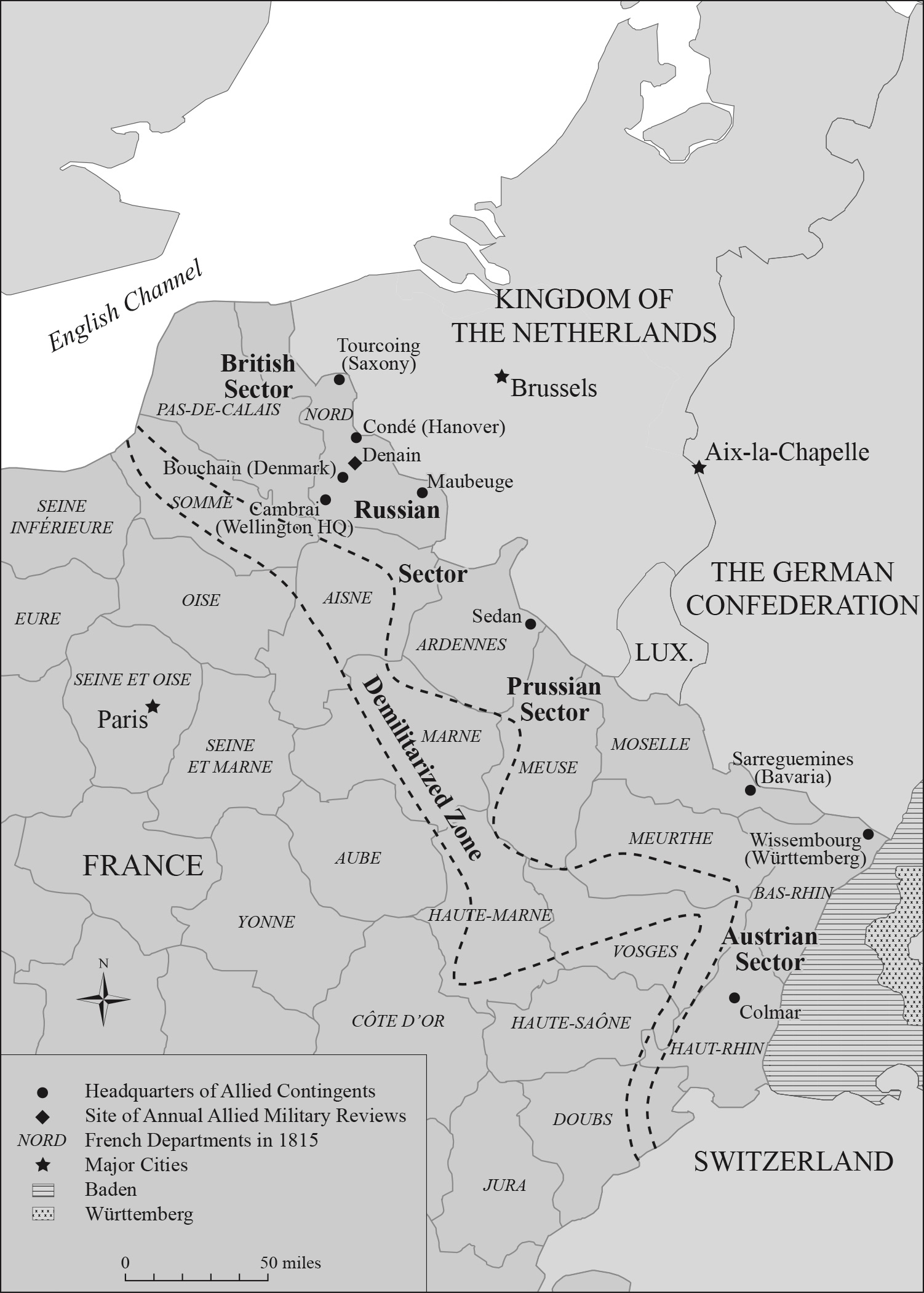
Map of the occupation zones of the foreign “Occupation of Guarantee” in northeastern France from 1815 to 1818. Map © Christine Haynes, used with permission.
SIÈCLE: So you talked about the “brutality” that was involved in this initial occupation. How did the treaty occupation compare in terms of its impact on the people who were being occupied?
HAYNES: I should say that even during the initial military occupation there was some attempt to regulate it, and ultimately the invading armies were divided into particular zones and there was some attempt to systematize requisitioning, for example. The French government established a commission on requisitions that was supposed to negotiate with the Allied powers to try to ensure systematization and clear requisitioning processes as opposed to just pillaging by the troops. But that didn’t work that well. A lot of the violence continued into the fall of 1815. So it was really only through this treaty of November 1815 and the institution of the Occupation of Guarantee that it became more systematized.
All requisitioning was then organized by the French Ministry of War. They would contract with their suppliers and also with local communities, and they managed this process of supplying the occupying troops. Those troops were supported at the expense of the French, to the tune of 50 million francs per year to pay and equip the troops, and another 100 million francs per year to supply their rations. So there was a very systematized rationing process.
That did not mean that there wasn’t violence. So in the book, I really try to examine the spectrum of relations between occupier and occupied, and they did vary widely depending on the nationality of the occupier, varying with class. Particular communities seemed to get along better with the occupiers than others, depending somewhat on the commander of the occupying forces. So there was a lot of variety. But ultimately, I think, the spectrum falls somewhere in between what I call on one hand ‘enemies,’ and on the other ‘friends.’ And ‘friends’ with a question mark, because I think ‘friends’ is a bit of a strong term to characterize even the most positive relations between occupier and occupier.
The title of the book comes from a song that was popular at the time by a songwriter called Pierre-Jean de Béranger, who as the Allies were getting ready to invade again during Napoleon’s Hundred Days, wrote a song about the ‘demoiselles’ or prostitutes of the Palais Royale in Paris, who he said would profit from increased business again, just as they had in 1814 from the Allies coming back into France. And the refrain of this song is, ‘Long live our friends, our friend the enemies,’ playing on this ambivalence, contradiction in feelings on the part of the French and their attitude toward the Allies.
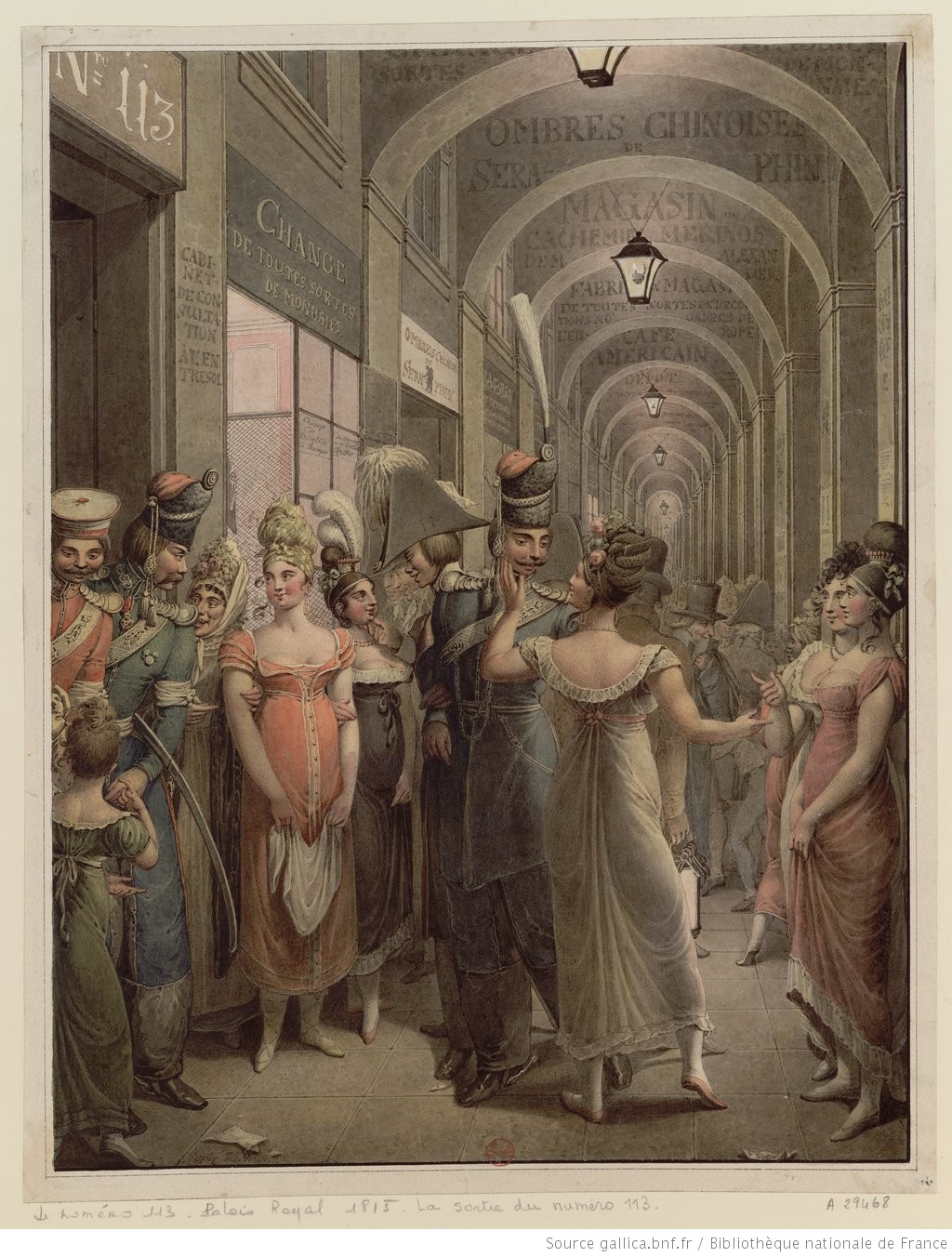
An 1815 drawing showing French prostitutes in Paris’ Palais Royal in the company of foreign soldiers. Georg-Emmanuel Opiz, “La sortie du n° 113” (1815), public domain via Bibliothèque nationale de France.
In the book, the first part is about how the French and the Allies, the Allied occupiers, really remained enemies throughout this peacekeeping occupation, the full three years that it lasted between 1815 and 1818. I talk a lot about the heavy burden represented by lodging and supplying the troops. They had to house these troops, often in very small communities, in barracks, and when these weren’t available, in private houses, living cheek-by-jowl with the local French. And then they had to supply them not just with food, forage — like I said, the horses represented a significant burden — furnishings of various kinds, practice fields, churches, kitchens, lighting, heating — so all kinds of supplies they had to provide to the occupiers. And this was during a period in which the French were recovering from war, and in 1816 there was the so-called ‘Year Without a Summer,’ in which there was this very, very wet and cold summer as a result of a volcanic eruption in Indonesia. So grain was very scarce and the French themselves were starving. So this burden of having to house and feed the occupiers, I think, was all the more acutely felt because of that.
And then, like I said, violence really continued, at least sporadically, throughout the three years of occupation. There continued to be verbal as well as physical violence, including assaults, brawls, murders and rapes, and then also attacks on cultural property. The Louvre Museum, for example, had much of its artwork, a lot of which had been taken by Napoleonic armies from other European powers, and brought to Paris, a lot of it was taken back during the military occupation, and continuing into the occupation of guarantee. So there was definitely a lot of violence.
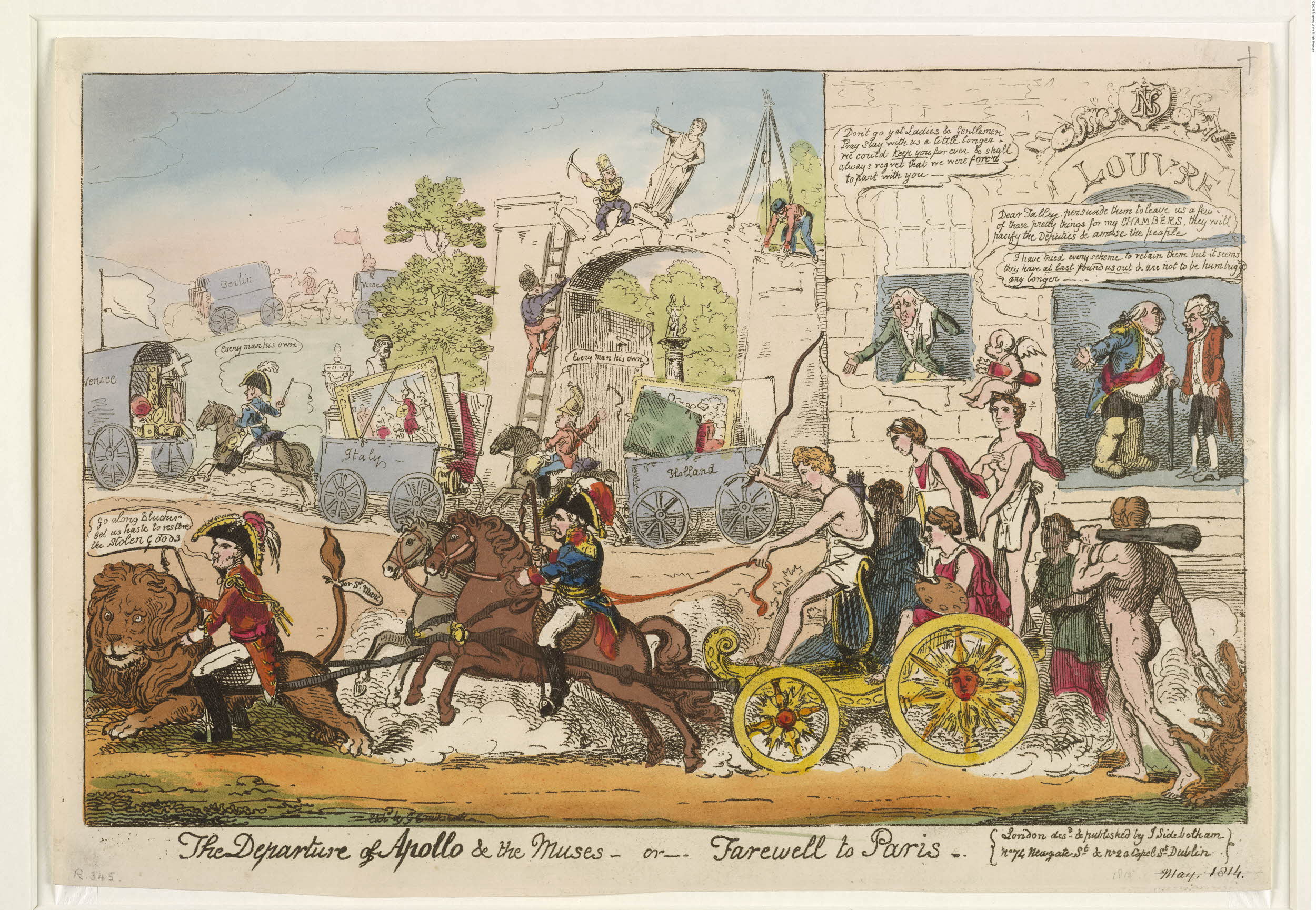
A contemporary political cartoon shows art treasures being reclaimed from the Louvre by their nations of origin, while King Louis XVIII begs Talleyrand to persuade the Allies to “leave us a few of these pretty things” because “they will pacify the [Chamber of] Deputies & amuse the people.” George Cruikshank, “The departure of Apollo & the muses—or—farewell to Paris” (1815), CC BY-NC-SA 4.0 via the British Museum.
On the other hand, in the second part of the book, I talk about the more positive relations that sometimes develop between occupier and occupied. This was partly due to concerted cooperation between Allied occupying officers and local French authorities on things like discipline, policing, justice — when offenses occurred, they were often brought to trial by the French justice system and Allied courts-martial. And then there was significant accommodation. I wouldn’t go so far as to call it collaboration, I think that’s an anachronistic 20th Century term. But there was a lot of cooperation and accommodation between Allied forces and local French people, especially among elites. The Russian officers, for example, tended to speak French and often got along very well with local authorities, joined them in balls, at the theater, for dinners, hunting. So there was a lot of socialization, especially at the elite levels. But even among the lower classes, there was considerable fraternization, sometimes resulting in romance, illegitimate children (whose numbers went up during this period), sometimes even marriage. In the book I really try to convey the broad range of experiences of both the occupiers and occupied during these three years.
SIÈCLE: What was the experience for the occupiers during this time, of the soldiers who were uprooted and posted in another country for several years with a perhaps sullen-at-best population?
HAYNES: It also ranged widely. It’s interesting: at all social levels, there was some hostility, reluctance to engage with the local population, especially among the Prussian corps, but also to a certain extent the British. The British had a reputation for being somewhat standoffish with the local French. Among other contingents, I think there was a lot more exchange. Austrians, for example, in Colmar, the commander von Frimont socialized quite a bit with the local prefect in Colmar. He would bring officers with him to mix with the local notables, and they had numerous dinners and dances and outings, hiking, hunting, etc., in the surrounding area. In fact, when the occupation was ending, the locals bestowed a lot of honors and letters and gifts on von Frimont and he remained in contact with a lot of local authorities in that town for years afterward. So there are examples like that of considerable fraternization, especially among elites, but like I said, even farther down the social scale, too.
And then, you know, even amongst soldiers, some became involved with local women. Some even stayed after the occupation. There are numerous cases of men who remained and married local women, or tried to set up trade in the communities where they had been stationed, or later applied for naturalization in France. I think that was especially true among the Russians — they had lifetime military service in Russia, so they were not in any hurry to go back home after the occupation.
For some of the men at least, among these troops, France represented a more civilized, liberal (even though the king had come back) — they were exposed to new ideas, had a better quality of life perhaps, even in these small villages during this time of dearth in eastern France than they might have had at home. There are at least anecdotal accounts of some of them crying when they had to leave, because they had actually been quite happy during the three years of occupation. Remember, they had been at war for twenty years, and now at least there was no actual combat. They were just responsible for standing guard in these communities.
SIÈCLE: You share a really fascinating anecdote in your book, I believe, about how even something as simple as dancing could be a real flashpoint. Could you talk a little about that, and some of the other cultural misunderstandings that happened when you had people from all over Europe stationed on an unwilling French population?
HAYNES: Yes, I’m really glad you brought that up, because I think dancing is a good example of the both negative and positive relations during the occupation. Dancing could be a real flashpoint. A lot of the brawls that broke out in local communities happened over dancing, and usually over the question of exactly which dance step was going to be performed in a cabaret or — usually not in an elite ball, but in a tavern or cabaret, there would be conflict over what kind of dancing was going to happen. Because the French usually danced the contre-danse, and German soldiers in particular, but [also] other Allies had begun to adopt the waltz. And then the Russians had dances like the polonaise or the mazurka. And so there would be conflict over whose dances were going to dominate in a given evening — to the point that eventually some of the Allied authorities began to pass regulations that said that these dance steps had to be alternated if an evening of dancing was going to be organized. So it could be a point of contention, but it was also a point of socialization and fraternization between the occupiers and occupied. There are numerous accounts of French bourgeois and Allied officers organizing dances to which they would invite Russian troops, who were known to be good dancers, to socialize together.
After the occupation was over, as a result of the occupation, I think the spread of many of these dance steps across Europe and the mixing of them in social settings, not just in France but elsewhere, really spread. So this is an example of one of the main things I try to emphasize in the book, which is the cross-cultural exchange that happened as a result of the occupation.
SIÈCLE: Speaking of cross-cultural exchange (I believe this is from a different book and not from yours) one of my favorite anecdotes of this period talked about all the wine that the foreign officers would seize from the French and drink, often without paying, especially in the earlier days. The observation from one women from Champagne who noted, ‘They are drinking, they will pay.’ And in fact in the years after this, once they could no longer seize champagne, the rich of Europe started buying it in vast numbers. The occupation helped kick off this massive change in tastes due to this exposure to French wine.
I wanted to use that to kick off what you were talking about, a brief discussion of sort of the long-term impact and cultural impact of this cross-pollination of cultures of Europe coming to France, and the impact that that had.
HAYNES: Yeah, I think it has really been underestimated, and I love that anecdote — I was never really able to establish the truth of it. I think that was one of the things that most fascinated me about this project, was the intense cross-cultural exchange that was happening, and the repercussions that that had across Europe through the 19th Century. There were definitely — the occupiers when they left exported not just wine but various eating habits. The restaurant, which was a new phenomenon — Rebecca Spang has written about this, in Paris, beginning in the Revolutionary and Napoleonic periods. Foreign officers, but even some troops, because they were relatively inexpensive for British troops, for example, in Paris, experienced the restaurant and took some of these new dining habits back with them when they left.
Fashions: there are reports of the wives of British officers loading up on dresses to take back with them when they left. The Prussian king apparently came to the boutiques in Paris to buy dresses and such for the members of his family. So there was a lot of that sort of exchange happening. I haven’t really traced it in detail in the years after this, but I think certainly it shaped European culture and really Frenchified it over the succeeding decades.
I think this is true in literature, too. We’ve underestimated the extent to which romanticism, as an international movement, is facilitated by the occupation and just more broadly the re-opening of France and the continent to the British in particular after the Napoleonic Wars. There was just intense, intense exchange going on in this period in a way that hadn’t been possible except among émigré communities or among members of the military who were traveling around in the two decades before this.
SIÈCLE: One of the other things you talk about in your book is the impact of this Occupation of Guarantee as sort of a legal, diplomatic precedent, and sort of a step towards the development of a new way that nations, and nations at war interacted. Could you talk briefly about that?
HAYNES: Yes. I think that’s one of the most important conclusions of the book, and most important findings of the book, is that not just the problems but the solutions to the problem of exiting from war that have been explored, more for 20th Century wars, the kinds of peace settlements and especially the use of occupation for peacekeeping purposes that we associate, that have been dated really to the late 19th Century at the earliest, and associated mostly with the two world wars, that those were already present and really originated with the aftermath of the Napoleonic Wars.
SIÈCLE: I think 20th Century history fans might find the idea of dividing an occupied country into zones assigned to different countries might very familiar.
HAYNES: Exactly. It’s very striking really how much this occupation was foreshadowing a lot of what would happen, not so much after World War I, because I think that was a very different kind of peace settlement, and the negative consequences of that played out in the interwar period, but it’s very similar to the approaches of the Allies after World War II. This idea that you need to have a settlement and you need to use occupation for not just peacekeeping but for rebuilding, reconstructing the country, that was very much the idea of the Allies in 1815.
This was really a new approach to military occupation, using it not so much for conquest, which it had been used for up to this time, including during the Revolutionary and Napoleonic Wars themselves, but for reconstruction, and not just of the state, but of the entire people. This was really an effort to re-stabilize France politically and reconcile the French people with the community of nations. I think that was a very novel and important development in international diplomacy, international law.
SIÈCLE: Professor Haynes, thank you for coming on. Before we wrap this up, are there any stories or anecdotes that you discovered in your research that you particularly want to share?
HAYNES: Yeah. When we were talking about cross-cultural exchange, or cosmopolitanism, I should have said that one thing that’s really interesting about this period, and this goes back to how I got interested in this topic in the first place, is during the late eighteen-teens, France was inundated not just with all of these Allied troops, but also with civilians from other parts of Europe, and particularly from Great Britain. Some fifteen to twenty thousand Brits were visiting France and especially Paris throughout the late eighteen-teens. And they were part of this importing and exporting of idioms, fashions, dance steps, etc., that we were talking about. But I forgot to mention that one of my favorite examples of the cross-cultural exchange and what I call cosmopolitanism happening in this period is what were called the montangnes russes, which literally means “Russian mountains,” and that’s still the word the French use to describe roller coasters. These were early versions of roller coasters, modeled after hills of ice that Russians would sled down during Carnival in Russia. It’s a little unclear exactly how they came to France in 1816, but I think it’s certain that French troops saw them when they invaded Russia in 1812, and then it exemplifies the Russian influence on French culture that was happening when Russians invaded in 1814 and again in 1815 to 1815.
A print of an early roller coaster near Paris circa 1820. “Promenades Aeriennes, Jardin Baujon” (c. 1820). Public domain via Wikimedia Commons.
These roller coasters became all the rage in Paris, and there were probably close to a dozen of them set up in parks around the outskirts of the city, frequented by Parisians, especially the upper and middle classes, but also all of the foreign visitors to Paris in this period. We have lots of accounts in travelogues and guidebooks of these “Russian mountains.” And then there were - they were such a cultural phenomenon that there are now two boxes of prints of them, images of them, in the national library in Paris; numerous plays were written about them; they really became a character in pop culture themselves. They didn’t last long in Paris at this time — there were some safety concerns, a couple of people died in accidents on them. But I think this is one of the more fun examples of the way in which the occupation and the resurgence of cosmopolitanism in the aftermath of the Napoleonic Wars really impacted French and European culture in this period. So I just wanted to mention that example.
SIÈCLE: I’m so glad you did. I thought about a way to try to work that in myself, but I’m glad you brought that up.
That wraps up my discussion with Prof. Christine Haynes, author of the new book Our Friends the Enemies: The Occupation of France After Napoleon. I highly enjoyed it and would encourage you to pick up a copy as well; you can find a link to do so at thesiecle.com/episode6, with six as a numeral. My thanks to Prof. Haynes for coming on the show, as well as her help in personal correspondence as I’ve researched this period for the podcast.
Be sure to check back in two weeks for a discussion of the strange parliamentary monarchy set up by the Bourbon Restoration, which combined some surprising liberalism with extremely limited voting rights. Much more on that in Episode 7: The Charter.
